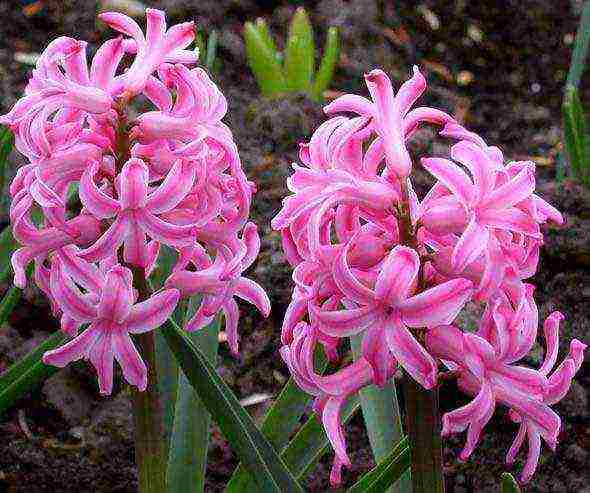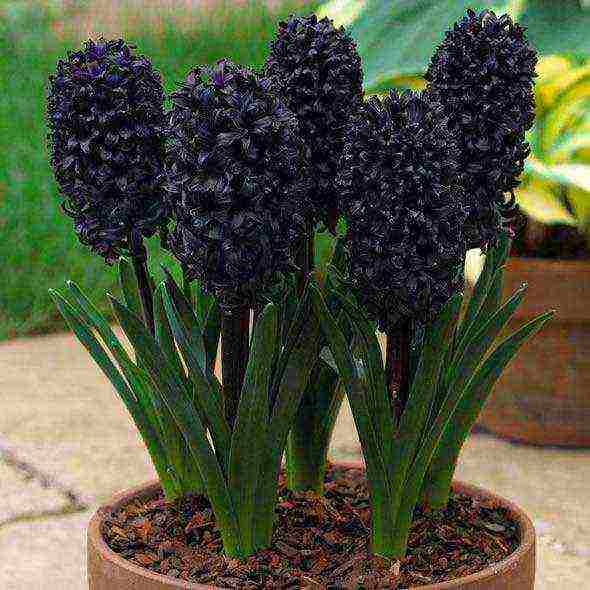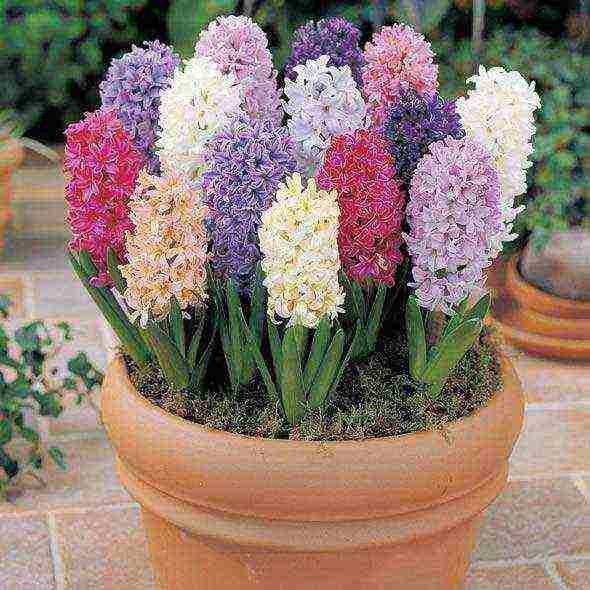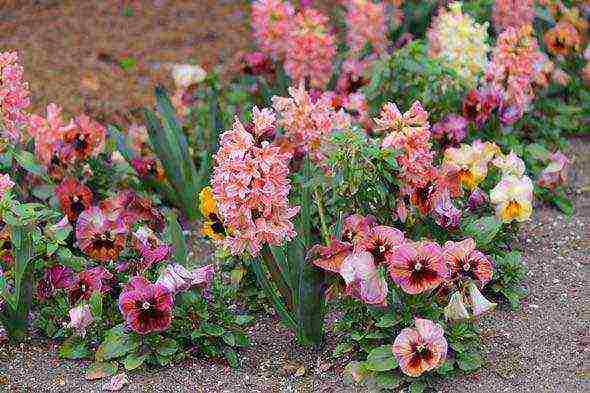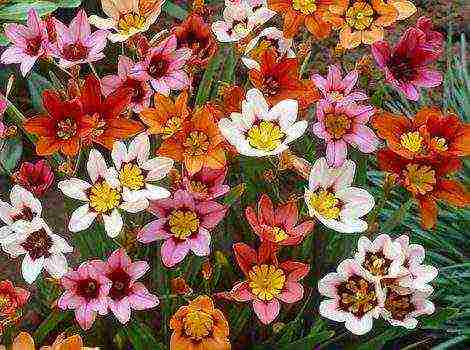Content
- 1 The choice of planting material
- 2 Selection of a place for growing hyacinths in the open field
- 3 Planting hyacinths
- 4 Planting dates for hyacinths for growing in the open field
- 5 Growing hyacinths outdoors and caring for them
- 6 Hyacinth care after flowering and harvesting bulbs
- 7 Storing hyacinth bulbs
- 8 Hyacinth - botanical description
- 9 Types and varieties of hyacinths
- 10 Choosing a place for growing hyacinths
- 11 Rules for planting hyacinths in open ground
- 12 Hyacinth care
- 13 Features of digging hyacinths
- 14 How to store hyacinth bulbs
- 15 Reproduction of hyacinths
Many summer residents strive to grow hyacinths in their area, planting and caring for which in the open field require a certain amount of time. In this article, we will look at how to grow these beautiful flowers (even in those regions where the ground freezes in winter), when to dig up hyacinths, how to store bulbs, how to propagate your favorite variety.
Hyacinths in a flowerbed (photo by Nadezhda Abramovich, Krasnodar)
In early spring, as soon as the snow melts, green arrows of hyacinths sprout from the ground. This flower with a charming and pronounced aroma differs in all shades of the rainbow. Inflorescences in the form of tassels can be either regular or terry in structure; there are usually 20-30 buds on the peduncle.
↑ to the content ↑ Planting hyacinths in the ground - the choice of bulbs and places for planting them
Perennial hyacinth is a bulbous crop, the size of the bulb may vary depending on the type of flower. The planting material is considered an adult by the age of 5-6, when it is fully formed. The tuber is a scaly sphere with a bud of renewal - it is this that affects its growth. By the 5th year, adult bulbs usually acquire babies, which are formed near the bottom and are hidden under the scales.
Hyacinth, photo of flowers:
When choosing tubers, you should pay attention to the following nuances:
- Terry bulbs are often smaller than their regular bulbs.
- To grow flowers outdoors, the tuber must have at least 4 cm in diameter, a full-fledged active bud and multiple scales. Elasticity and heaviness are indicators of the healthy state of the bulb.
- The appearance of the bulb should be perfect - no damage, loose sides, mold.
- On the lower part of the tuber (near the bottom), root primordia should be present.
- The bottom of a suitable bulb for planting should be about one and a half to two times smaller than the bulb itself (we are talking about volume).
The key to a long and lush flowering is not only high-quality planting material, but also the planting site itself. You can set up a flower garden near trees or bushes, but not very close to them. The place for plants should be calm, well lit by the sun's rays. The soil is needed loose, if your site is dominated by black soil or loam, then it is advisable to add peat to it in advance (sand is also possible). Sod land or deciduous humus are excellent conditions for the development, growth and flowering of hyacinths.
As a fertilizer, organic matter gives good results, but you should not use manure. If the soil is acidic (pH above 6.5), then it should be diluted with dolomite (limestone) flour. Hyacinth tubers do not like excessive moisture very much. If on your site groundwater runs close to the surface (closer than 0.5 m), you cannot do without arranging high beds.In addition, the plants will have to provide a high-quality drainage substrate, as well as make a slight slope of the ridge - for better outflow of water during rains, spring melting of snow. With the arrival of spring, high beds are warmed up faster by the sun's rays, hyacinths bloom much earlier.
↑ to the content ↑ Growing hyacinths in the open field
It is highly desirable to prepare the soil in advance - to dig it to a depth of about 40-45 cm and add the required additives (depending on the composition and condition of the soil). Limestone (200 g), wood ash (150 g), superphosphate (50-70 g), magnesium sulfate (10 g) or potassium (20 g) are added at an approximate rate of 1 m² of land. So that fragile young roots are not damaged during planting, digging up the soil in the place of the future flower garden is also important. During the deepening of the bulbs, the soil temperature should be approximately 8-11 degrees, the distance between the tubers should be no more than 10-15 cm.If the flowers are planted in the beds, then the row spacing should be approximately 18-22 cm.If you want different varieties of hyacinths bloomed at the same time, make sure that all tubers are approximately the same in size.
Hyacinth, photo of bulbs:
A good time to plant bulbs is mid September / October. It should be borne in mind that if you plant a tuber too early, then it will begin to develop, but it will not survive the winter. If you plant hyacinths too late, then they will not have time to take root and get used to the place - accordingly, they will also die. If you are late with planting, then hurry up by the first week of November - this is the latest date. To do this, you will have to resort to additional measures.
The place for the future flower garden is mulched with leaves or some other suitable material, covered with plastic wrap to keep warm. After the tubers are buried, the site is sprinkled with sawdust or peat, and it can also be covered again with foliage or coniferous spruce branches. A special covering material is excellent for this purpose. With the arrival of the first days of spring, the protective covering can be removed to make way for the emerging hyacinth sprouts.
As mentioned above, the bulbs should be healthy, but if you are still afraid of fungal manifestations, you can first soak them in a fungicide solution. The width and depth of the hole for the tuber should be equal to two of its sizes - about 15-25 cm, you can pour a little sand on the bottom, and then bury the tuber with the bottom down (about 13-15 cm). Sprinkle the bulb with soil, which needs to be tamped lightly, then watered. The root system of the plant absorbs moisture and nutrients from the ground within a radius of about 20 cm from the tuber - this should be taken into account. Small onions should not be deeply buried; they should also be planted quite thickly.
↑ back to content ↑ How to care for hyacinth
After the protective cover is removed, caring for the plants will consist in weeding, regular watering, loosening the soil, and applying top dressing. It should be borne in mind that hyacinths are bad for the neighborhood of weeds. When buds begin to set and flowering time comes, fertilizing the soil becomes especially relevant. After sprouting, the flowers can be fed with saltpeter (25-30 g per 1 m²).
The second stage of fertilization follows during the period when the buds are gaining color. Now, in addition to ammonium nitrate, you can add potassium chloride (25 g) and a phosphorus additive (for example, superphosphate, 35 g). At the end of flowering, superphosphate and potassium chloride are applied to the site - 35 g of each product per 1 m² of the area. The aisles or spaces between flowers are treated with fertilizers; after top dressing, watering always follows.
Hyacinths - how to care after flowering? Unfortunately, this wonderful period is fleeting; after the flowers dry, the roots should be saturated with moisture.For tubers to recover well after flowering, watering and fertilization should be in the first place. If you live in a "cold" region, then you cannot leave hyacinths for the winter, they will have to be dug out - these are necessary measures for the further favorable formation of replacement buds.
If you live in the Kuban, in the Crimea, in the north of the Caucasus, then the annual digging of tubers can be avoided, but only under the condition of a very hot summer. It should be borne in mind that the bulbs left in the ground will give much fewer flowers next year.
From my experience, I can share this observation: I accidentally dug up several hyacinth bulbs, forgetting that they grew in my place. I didn’t begin to dig in, as it was urgently necessary to plant a rose seedling. And I forgot about them, leaving them lying on the porch. Accidentally stumbled upon them only in the fall. Planted. And in the spring I was surprised by the large peduncles, abundantly dotted with flowers, which crawled out of the ground in this very place. Other hyacinths bloomed too, but their blooms were much more modest, something like the one in the photo below.
Hyacinths have not been transplanted for a long time (photo by Anna Nepetrovskaya, Novokubansk, Krasnodar Territory) ↑ back to content ↑ When to dig out hyacinths after flowering
The optimal period is the last weeks of June - the first half of July, when the leaves of the plant turn yellow and weak. The ground part of the flower is removed, the tubers are removed from the soil, washed with water and thoroughly dried. Then we carry out an audit - we throw away the damaged (or with obvious signs of illness) specimens. If there are undeveloped babies on the bulb, they are separated and put aside for growing. Before storage, all tubers are subject to treatment against diseases and pests.
Planting material, photo:
After all the manipulations, the bulbs should be aged for about 7-10 days in a well-ventilated place at an air temperature of +17 .. + 20 ° C. To do this, they need to be laid out on clean paper, and after the specified time has expired, they must be hidden in paper bags. It is the period after flowering, as well as the processing and storage time of tubers, that are most important for hyacinths. At this time, the acclimatization of the planting material occurs, the scales dry up, the tubers are prepared for the summer period.
At a sufficiently high summer temperature, air access and moderate humidity should be provided to the bulbs (if the thermometer reaches + 30 ° C). About three weeks before planting, the temperature in the room with the bulbs should be lowered to + 16 ° C to help them adapt before planting.
↑ back to content ↑ How to propagate hyacinths at home
Separately, it is worth considering the methods of reproduction, since the tubers can give flowers for two or three years, but at the same time they will not form children. For this, the bulbs need stimulation, it is carried out in various ways.
↑ to the content ↑ Cutting the bottom of the hyacinth tuber
Even during planting, the place where the largest bulbs are planted is determined on the site. After the leaves of the plant turn yellow, the tuber is removed from the ground and immediately, without letting dry, arrange a "shower" under the strong pressure of water. During this process, old scales are removed along with the ground. Next, the bulbs are laid out in one layers in a ventilated box, taken out to a shaded place, dried for about 7-10 days. After this time, using a sharp knife, a wedge-shaped cut is made on the bottom, in which the kidney and the bottom itself are completely removed. The cut site must be treated with crushed activated carbon.
After this operation, the tubers are laid out in a container, the bottom of which is covered with a layer of perlite. The bulbs should be placed with the cut bottoms up. Next, the container is placed in a large plastic bag (you can use garbage bags) to create the required microclimate.At a temperature of + 30 ° C and high humidity, babies will appear at the cut site, and after 2-3 months they will reach about 1 cm, acquire root rudiments and sprout small processes. If the bottom was cut out in the first months of summer, then the tuber with children can be planted in the soil and covered with sawdust (or peat).
If time is missed, then the tubers are turned upside down, placed in a container with soil, placed in the cold (refrigerator, basement), and with the onset of spring they are planted on the site.
After the hyacinths have faded, what to do with them? With the onset of August, these tubers are dug up (by that time they are already covered with children), the children are separated. By early September, the young generation of hyacinths is buried in the soil, covered with a 10 cm layer of mulch (sawdust, spruce branches, foliage, peat). At the end of the first wintering, the mulching layer is removed, but left in place after the second winter. In the third year, these hyacinths give color and delight you with a wonderful aroma.
↑ to contents ↑ Reproduction by scales from bulbs
Large tubers (about 5-6 cm in diameter) are cut into 4 parts, after which some scales are separated from the bottom, the "wound" surface is treated with crushed activated carbon. Next, a container is taken, at the bottom of which perlite or clean sand is poured; you can also use crushed charcoal with ash. Broken flakes are placed in this container, then it is placed in a transparent plastic bag, tied securely and kept for 2 months in not too bright light.
At the same time, the air temperature should be approximately + 19..23 ° С, but at the second stage, which lasts a month and a half, the temperature should be reduced to + 16..19 ° С. During this period, several bulbs will be tied on the scales. Young stock storage is similar to the method described in the first method.
↑ to the content ↑ Propagation of hyacinths by cuttings of a leaf
To do this, you should wait for the period of the ovary of the peduncles and separate from the hyacinths by a couple of sheets, they must be cut as close to the base as possible. Then the leaves are treated in a solution that stimulates root formation (for example, "Heteroauxin") and buried 3-4 cm in a container with clean sand (or perlite). This container, again, is enclosed in a plastic bag, tied up and placed in a moderately lit place for a month and a half. The air temperature should vary within + 10..17 ° С, humidity - 80-90%. After the specified period, you can see bulbous buds on the cuttings, and after 50-60 days - young roots and small leaves. Further, the plants are planted on the site, each stalk subsequently gives 6-10 children.
↑ to the content ↑ Notching the bottom, as a way of reproduction of hyacinth
In this procedure, the end is not removed, as in the first case, but is cut crosswise. A couple of crosses are made on large tubers, on those that are smaller - one. The damaged areas are treated with powdered activated carbon, then the bulbs are placed in a warm room for 24 hours (+ 20..22 ° C) so that the “crosses” open up. All further actions are similar to the above recommendations. With this method of stimulating the tuber, it is possible to obtain about 10-16 large young bulbs.
For these messengers of spring to please you with long flowering, the splendor of the tassels and an amazing aroma, you need to make an effort. Now you know how to grow hyacinths, planting and caring for them in the open field, although they are fraught with difficulties, are undoubtedly worth the effort and time.
First flowers (photo by Lyubov Belykh, Krasnodar)
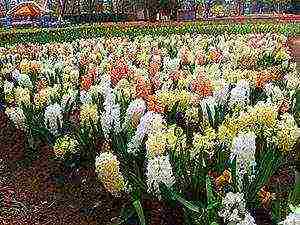 Natives of the Mediterranean and Southeast Asia, hyacinths bloom in early spring, striking with the aroma spreading in the air and a riot of color from white and all shades of blue to yellow and even deep burgundy.
Natives of the Mediterranean and Southeast Asia, hyacinths bloom in early spring, striking with the aroma spreading in the air and a riot of color from white and all shades of blue to yellow and even deep burgundy.
South of the North Caucasus, fragrant flowers are found even in the wild.On the mountain slopes and in the valleys, you can see arrows with blue or pink buds making their way from under the snow. It is not difficult to grow hyacinths in open ground, subject to a mild winter and frost-free soil.
Appearing above the ground, the bright green glossy leaves of the plant gradually open up, and a cluster inflorescence with 20-30 buds begins to rise from the middle. The flowers of modern varieties of hyacinth are tubular, funnel-shaped or bell-shaped, can be ordinary and double, and always have an unusually rich aroma.
 How to plant hyacinth in the middle lane, where the soil invariably freezes, how to take care of the plant in order to get consistently lush flowering?
How to plant hyacinth in the middle lane, where the soil invariably freezes, how to take care of the plant in order to get consistently lush flowering?
The choice of planting material
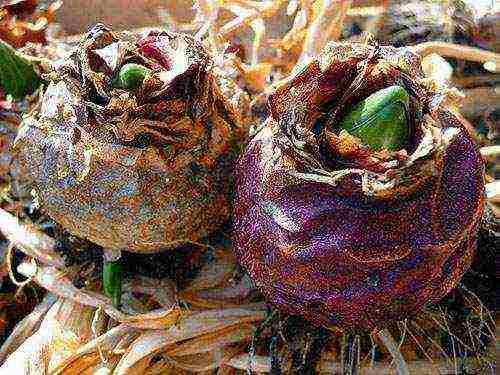 Hyacinths are typical bulbous plants. Perennial bulb of this type:
Hyacinths are typical bulbous plants. Perennial bulb of this type:
- fully formed by the age of 4–6;
- has a spherical shape with a prominent neck;
- consists of numerous scales, the inner ones are dense and fleshy, and the upper ones are thin and outwardly similar to parchment.
The growth of the bulb is due to the regeneration bud formed in the core, which consists of several primordia of leaves and the future peduncle. Adult bulbs 5–6 years old at the bottom under storage scales form the rudiments of daughter bulbs - children.
 Moreover, depending on the variety of hyacinth, its bulbs can have different sizes. As a rule, bulbs producing double flowers are smaller than usual.
Moreover, depending on the variety of hyacinth, its bulbs can have different sizes. As a rule, bulbs producing double flowers are smaller than usual.
- If hyacinths are to be grown in the open field, by the time of planting the bulb should be elastic, at least 4 cm in diameter and consist of several surface scales, 6-10 accumulation scales and a fully formed bud.
- On the outer surface of the planting material there should be no mechanical damage, traces of mold, diaper rash or lethargy.
- Looking at the bottom of a high-quality bulb, you can see two-millimeter root buds.
- The diameter of a high-quality bulb is one and a half times the size of the bottom.
Such planting material will not only successfully root and overwinter, but will also give abundant flowering in the spring.
Selection of a place for growing hyacinths in the open field
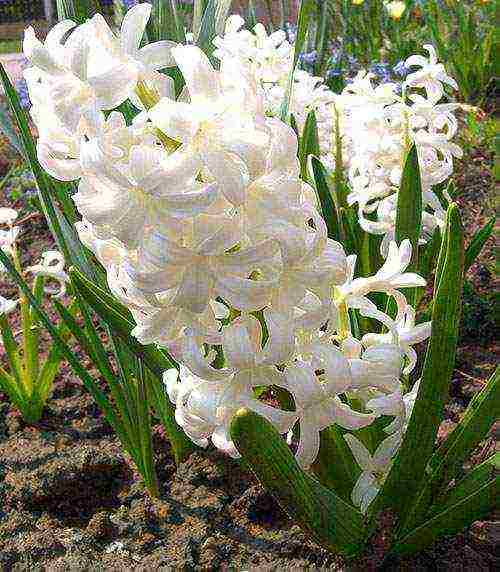 A competent choice of a place for planting hyacinths in open ground and caring for plants before and after flowering is the key to a long spring flowering.
A competent choice of a place for planting hyacinths in open ground and caring for plants before and after flowering is the key to a long spring flowering.
The area where hyacinths are to grow should be well lit, which in spring, when there is still little foliage, is easy to provide. But you will have to take care of protecting the flower garden from the wind.
Many gardeners make the mistake of planting bulbs under tree tops or near tall shrubs. On the one hand, such large vegetation will really save the inflorescences from the cold wind and will not shade until the foliage blooms. On the other hand, when it comes time to dig up hyacinths after flowering in the garden, the bulbs may not have enough nutrition to replenish their strength, which will affect their quality.
- Hyacinths prefer loose soil. It is better to mix clayey soil or black soil with peat or river sand.
- The growth of bulbs and the quality of flowering are positively influenced by the abundance of high-quality organic matter, but feeding with fresh manure can harm hyacinths.
- The acidity of the soil should not exceed 6.5 units, if the pH level is higher, lime flour is added to the soil.
Hyacinth bulbs react extremely poorly to waterlogging. If the groundwater at the site approaches the surface closer than half a meter, high ridges are arranged for planting hyacinths or powerful drainage is needed. To ensure the outflow of spring or rain moisture, a slight slope is sometimes made.
All preparatory work for planting hyacinths in the open field and caring for bulbs is best done at the end of summer. In a month or two, the soil will settle, and the autumn rooting of the bulbs will be faster and easier.
Planting hyacinths
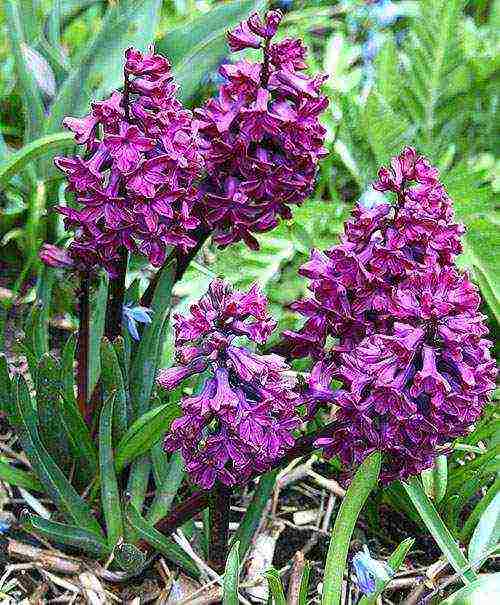 The soil under the hyacinths is dug 40 cm and at the same time the following is added per square meter:
The soil under the hyacinths is dug 40 cm and at the same time the following is added per square meter:
- 10-15 kg of well-rotted manure or humus;
- sand and peat, depending on the type and condition of the soil;
- 250 grams of limestone or 15 grams of magnesium sulfate;
- 200 grams of sifted wood ash or 30 grams of potassium sulfate;
- 60 to 80 grams of superphosphate.
If hyacinths are to be grown in the open field on sand, poor in minerals and organic matter, it is recommended to increase the amount of potassium and magnesium applied by one and a half times. The roots of the plant collect moisture and nutrition within a radius of 15–20 cm from the bulb. Therefore, the planting holes are made approximately of this size, deepening the bottom of the hyacinth by an average of 15 cm.
The finer the planting material, the higher the bulbs are embedded in the soil and the thicker they are in the flower bed.
In low-lying areas, hyacinths can be planted on a layer of sand, slightly pressing the bulb into it. This will protect the roots and the entire plant from rotting and possible infections. Flowering can be accelerated by planting bulbs on high ridges, which with the onset of spring will warm up much faster than a flat area.
Planting dates for hyacinths for growing in the open field
 In most regions of Russia, hyacinths can be planted in the ground from early September to mid-October.
In most regions of Russia, hyacinths can be planted in the ground from early September to mid-October.
- If the bulbs hit the ground earlier, or the fall is unusually warm, the plants start growing and die when frost sets in.
- If you are late with planting, the bulbs will not have time to root by the time the soil is frozen.
Nevertheless, it is possible to embed the bulbs in the soil in the first weeks of November. For this, the landing site must be covered with foliage or other suitable material in advance and covered with a film. The soil will keep warm, and the bulbs trapped in it will begin to grow as they should.
For the winter, it is better to shelter the planting sites of hyacinths from frost with the help of mulch from peat, sawdust, foliage or spruce branches. It will be necessary to remove the shelter in early spring so as not to damage the emerging sprouts.
Growing hyacinths outdoors and caring for them
 After planting hyacinths, outdoor care is reduced to regular feeding, loosening the soil, weeding and watering, especially during a set of buds and flowering.
After planting hyacinths, outdoor care is reduced to regular feeding, loosening the soil, weeding and watering, especially during a set of buds and flowering.
- Immediately after the emergence of sprouts, hyacinths need the first feeding at the rate of 30 grams of ammonium nitrate per square meter.
- The second fertilization occurs during the period of blooming of the buds. In this case, not only 20 grams of ammonium nitrate per meter is applied under the hyacinths, but also 30 grams of potassium chloride and 40 grams of superphosphate.
- When flowering is over, the plantation is fertilized at the rate of 40 grams of superphosphate and the same amount of potassium chloride per square meter.
All top dressing is applied to the aisles or the space between plants, covering 10 cm, and then the plantation is watered. Yes, and caring for hyacinths after flowering in the garden also begins with watering, which is extremely necessary in the first two weeks after the flower stalks dry.
Hyacinth care after flowering and harvesting bulbs
 The bloom of hyacinths is magnificent, but fleeting. After drying the peduncles, the plant quickly loses its decorative effect. When the hyacinths have faded, what to do next in the garden? First of all, especially if the plantings of spring bulbs are combined with some other ornamental crops, the location of hyacinths should be noted. After all, soon, when the leaves droop, it will be extremely difficult to find them. Then, plants that recuperate after flowering need high-quality watering and feeding.
The bloom of hyacinths is magnificent, but fleeting. After drying the peduncles, the plant quickly loses its decorative effect. When the hyacinths have faded, what to do next in the garden? First of all, especially if the plantings of spring bulbs are combined with some other ornamental crops, the location of hyacinths should be noted. After all, soon, when the leaves droop, it will be extremely difficult to find them. Then, plants that recuperate after flowering need high-quality watering and feeding.
If in a Mediterranean climate the bulbs tolerate winter well and again delight with bright arrows of inflorescences, then in the middle zone of heat during the dormant period, hyacinths are clearly lacking. So, do you need to dig up hyacinths every year? Yes, it is precisely such a measure in the middle lane that will help create the necessary conditions for the bulbs for the formation and development of the bud of compensation and the rudiments of the future flower arrow.
If healthy bulbs of hyacinths in a temperate climate, without digging for the summer, are left for wintering in the ground, their flowering next year will be much weaker than before.Only gardeners in the Kuban, North Caucasus, Crimea and the south of the Black Earth Region can not burden themselves with the annual digging of bulbs, and then only with a fairly hot summer. When to dig up hyacinths after flowering in the garden?
The best time to harvest the bulbs is in the last decade of June or early July. By this time, the leaves turn noticeably yellow and weaken at the base, now they will be easy to remove.
Storing hyacinth bulbs
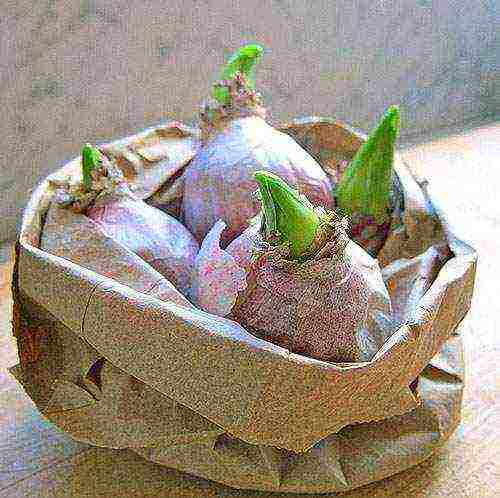 When the bulbs are free of soil, rinsed and dried:
When the bulbs are free of soil, rinsed and dried:
- they are examined, separating diseased or damaged specimens during excavation;
- separate children requiring rearing;
- planting material is treated with pests and diseases for bulbs.
Then, for a week, the bulbs are kept at a temperature of about + 18–20 ° C in a ventilated room and placed in paper bags or containers in 1–2 layers.
Caring for hyacinths after flowering in the garden and storing the bulbs turns out to be the most serious undertaking for the grower.
During this time, the covering scales of the hyacinths dry up, the plant acclimates and is ready for the next stage of storage, when for two months the bulbs must be at a temperature of about + 30 ° C, sufficiently high humidity and good ventilation. A month before planting, the air temperature is lowered to +17 ° C, so that the planting material can more easily transfer the upcoming planting of hyacinths into the open ground.
Planting hyacinth in a flower bed - video
Hyacinth, or rain flower, as it is popularly called, blooms in the garden one of the first, delighting with fragrant, bright flowers. Hyacinth flowers come in all sorts of colors: from snow-white to purple hues. This is a versatile plant, you can plant bulbs in open ground, used for cutting, and as a house flower. Today we will talk about hyacinths, planting and care in the open field.
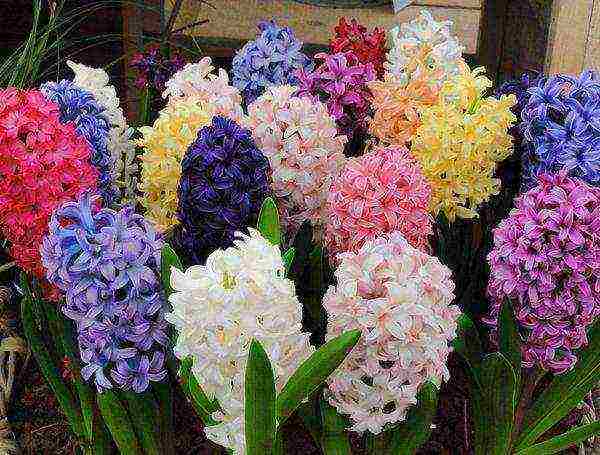
Hyacinth - botanical description
Hyacinth belongs to the genus of plants in the asparagus family. This flower has a dense bulb that consists of fleshy lower leaves. They occupy with their bases all the bottom of the mother's bulb. From the bottom there is a continuation in the form of a flowering stem. After flowering, the green flowering stem and leaves dry out. In the corner of the top of the green leaves inside the bulb, a bud forms on the stem. It grows into a young bulb that blooms the following year.
Often in the corners of the remaining green leaves, babies form, weak bulbs that separate. They can bloom in three years. The hyacinth flower forms as a brush at the top of the stem. The perianth with bent lobes, it is brightly colored, is a bell-shaped funnel. The fruit appears in the form of a leathery capsule, in which there are three nests, each with two seeds.
Types and varieties of hyacinths
There are a lot of types and varieties of hyacinth, we present only the most popular of them:
- Oriental hyacinth is the most common species. One bulb gives one peduncle, up to 23 cm high, up to 35 flowers bloom on it. It can bloom for up to three weeks.
- Edelweiss has a wide inflorescence of 15-20 snow-white flowers. Blooms early, in mid-April.
- Lady Derby. It was bred in Holland in the 19th century. It has an average flowering period, a very beautiful color: white with pink along the edge, and a raspberry-pink hue in the extended part.
- Maria. Early variety, height up to 25 cm, flowers are collected in a compact cylindrical inflorescence. The variety was bred in Holland in the 19th century. It was considered the most common flower in the USSR. The flowers are dark blue, the throat is white.
Choosing a place for growing hyacinths
Growing hyacinths should be carried out in a well-lit and windless area. You can plant hyacinth near trees, but in spring they can shade it, deprive the plant of nutrients. The site can be with a slope, so that water does not accumulate on it, the bulbs do not rot.
Groundwater should be at a depth of about 60 cm to the edge, otherwise it is necessary to drain expanded clay or a high bed. The soil for planting hyacinths must be permeable and nutritious. Slightly rotted or fresh manure should not be used. Peat and river sand are introduced into clay soil, and lime is added to acidic soil.
Rules for planting hyacinths in open ground
How to plant hyacinths? To plant this beautiful plant in open ground, you need to carefully prepare the soil, observe the terms and rules of planting. Then, in early spring, the most beautiful buds will sprinkle on the site, delighting with their varied colors and wonderful aroma.
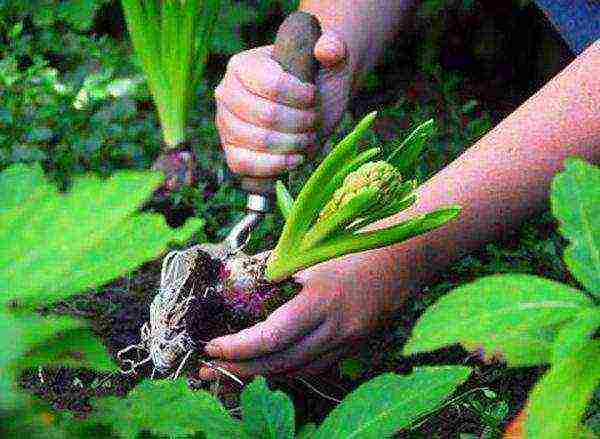
Planting timing and soil preparation
The soil must be prepared two months before the date of the proposed planting. When are hyacinths planted in the fall? The dates fall at the end of the silver. Planting in central Russia can be done until early November. The selected area is dug up, during deep digging, humus is introduced into the soil. Required:
- magnesium sulfate - 15 g;
- potassium sulfate - 30 g (or wood ash - 200 g);
- humus - 12 kg;
- sand;
- peat;
- superphosphate - 70 g.
With sandy soil, the amount of fertilizers with magnesium and potassium is increased by 1.5 times. If peat or humus is not added during digging, you can apply these fertilizers directly to the hole during planting of hyacinths. Nitrogen fertilizers should be postponed until spring.
The timing of planting hyacinths in the fall must be observed for one simple reason. If hyacinths are planted too early in the fall, they will have time to start growing and then die. For late planting, the site must be prepared in a special way; it must be protected from rain by covering it with leaves.
The choice of planting material and planting
It is necessary to select medium-sized bulbs, they are more robust. The planting depth of hyacinths depends on the size of the bulbs. Large bulbs (over 5 cm) are planted to a depth of about 16 cm, at a distance of about 18 cm. Small bulbs are planted denser and closer together.
It is necessary to make grooves or holes, pour a layer of river sand (about 5 cm). Press the bulbs into it, cover it with a layer of foliage, sand, and soil on top. This is the perfect fit for a hyacinth. The sand will act as drainage, it will not allow the bulbs to die from infection and waterlogging. Autumn planting of hyacinths should be carried out in moist soil, if the soil is too dry, it should be moistened, or the planting should be watered.
Planting hyacinth bulbs in large numbers should be carried out in high beds for easy care of hyacinths in the open field. The rows are made at a distance of about 23 cm, the bulbs are planted at a distance that should be equal to their three diameters. After planting hyacinths in the ground, before the very frosts, you need to cover with sawdust, dry peat, spruce branches, humus. The shelter must be removed in early spring, because hyacinth is a famous primrose.
Fertilizers for hyacinths
Top dressing is one of the main components of the competent cultivation of hyacinths.
When sprouts appear in the spring, it is necessary to apply mineral fertilizers. Florists advise 1 sq. meter add superphosphate (15 g), potassium chloride (25 g), ammonium nitrate (20 g).
At the stage of bud formation, you need to add one more top dressing - superphosphate (40 g), potassium chloride (20 g), ammonium nitrate (20 g).
The third feeding of hyacinths is carried out at the end of flowering. For her, take superphosphate (40 g), potassium chloride (40 g).
The soil must be loosened after each top dressing. If fertilizers are applied dry, then they are scattered and embedded in the soil. If in liquid, then first the hyacinths are watered, the dose of fertilizers is reduced.
Hyacinth care
Not only planting, but also hyacinth care should be given special attention. Hyacinth does not tolerate weeds. It is necessary to remove weeds and loosen the soil. This can be done immediately after sprouting. Loosening will help maintain the air regime of the plant.
Water the hyacinths abundantly, but not often.The main thing is that the water penetrates to a depth of 20 cm. During the budding period, you need to especially carefully monitor the moisture content of the soil. When diseased plants appear, they must be burned immediately. After flowering in the garden, the peduncle is cut with a knife. You only need to cut off faded flowers. It is necessary to draw a hand over the plant from the bottom up, what does not fall away must be left.
The main pests and diseases of hyacinths
In the open field, hyacinths very rarely suffer from diseases and pests. If, nevertheless, the danger overtook them, the reasons could be:
- The planting bulbs were initially infested.
- The planting was carried out on heavy, waterlogged soil.
- The hyacinths in the garden were planted after other bulbous or root crops.
- No preventive measures were taken.
- The rejection of the planting material after storage and before planting was not carried out.
- Fresh manure was used for fertilization.
- The plants were planted too often.
Infected hyacinths must be dug up and destroyed, the rest must be treated with preparations containing phosphorus. For prevention, you can treat the bulbs with phosphorus-containing preparations.
Most often, bulbous are affected by bacterial rot. The hyacinth bulbs turn into mucus. The disease can be recognized during the growing season. Plants lag behind in growth, spots and stripes appear on them.
Features of digging hyacinths
Why are hyacinths dug up? It has a number of positive aspects, the digging allows:
- inspect the bulbs in order to identify damage and disease;
- improve hyacinth flowering;
- select healthy children.
It is necessary to dig up the bulbs at the end of June, then the leaves of the plant are already beginning to deform and turn yellow. Nutrients at this time are used for the development of the bulb. If you dig at a later date, the ground part will already disappear, it is very difficult to find the bulbs without damaging them. The leaves of the plants are cut off, the soil is cleaned, the bulbs are dried in a draft in a dry room for 5-7 days, the temperature is 20 ° C. Then clean the bulbs from the roots, formed children, scales. Small children do not need to be removed.
How to transplant hyacinth? In the summer, you need to dig up the bulbs, as soon as they have faded, you need to store them until the fall. In the fall, hyacinths are transplanted to another place.

How to store hyacinth bulbs
The storage of hyacinth bulbs is different from conventional storage such as tulips or daffodils. A flower is formed during storage. For forcing and storage, it is necessary to sort by type and size. Sick, spoiled specimens are best removed. The bulbs are placed in boxes. For two months, the bulbs are stored at a temperature of 25-26 degrees, then they must be transferred to a place where it will not be higher than 17 ° C. High humidity must be maintained so that the bulbs do not dry out. You can spray the bulbs with water regularly.
Reproduction of hyacinths
To obtain new varieties, they use the seed method of propagation of hyacinths. Full-fledged plants can be obtained only after 5-7 years. Seeds are planted at the end of September in seedling containers, in a mixture of soil of humus and sand. For the first two years, you need to grow the plant in a cold greenhouse.
Reproduction naturally occurs very slowly. Only 1-2 children are formed per year. If you can easily separate the children, then they are separated and raised. If the children do not separate, the hyacinths are planted together with the children.
To obtain a large number of plants, for example, on an industrial scale, an artificial method is used for reproduction. The bulbs are disinfected in a solution of potassium permanganate, dried for a couple of days. Then they are prepared by incising and cutting out the bottom.
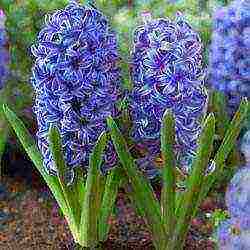 Hyacinth is an ornamental plant that looks like it came down to us from a vintage picture.After all, it attracts not only with its amazing beauty, but also with its extraordinary aroma! You will learn about planting and caring for fabulous hyacinths planted in open ground, as well as what varieties and methods of propagation exist, and, finally, how these flowers are used in landscape design and which plants are best combined with, you will find out in the article!
Hyacinth is an ornamental plant that looks like it came down to us from a vintage picture.After all, it attracts not only with its amazing beauty, but also with its extraordinary aroma! You will learn about planting and caring for fabulous hyacinths planted in open ground, as well as what varieties and methods of propagation exist, and, finally, how these flowers are used in landscape design and which plants are best combined with, you will find out in the article!
Description: varieties and varieties of hyacinths
The amazing hyacinth flower with the most delicate colors and captivating aroma is one of the first to bloom in the spring garden, driving gardeners crazy with its colorful and fragrant inflorescences. The rich color palette ranging from snow-white and yellowish to burgundy and resinous, complemented by the amazing shape of the inflorescences, amazes the imagination. It is not for nothing that hyacinth is called a versatile plant: this rain flower is excellent for planting in the ground and early forcing in greenhouses. You will learn more about how to plant and care for a plant, what breeding methods exist and how picturesque hyacinths are used in landscape design!
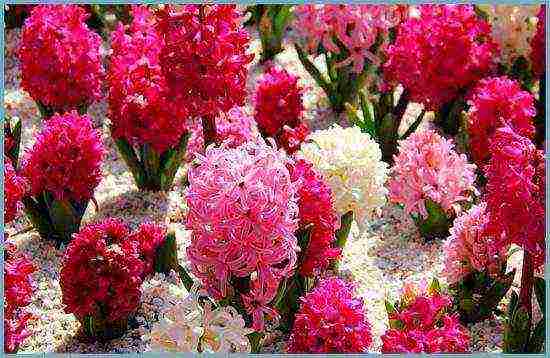
Hyacinths come in many colors and shades.
The homeland of hyacinths is Asia Minor and Greece. Here, at every step, you can find a wild flowering plant. Flowers owe much of their popularity to Holland, where famous breeders were actively involved in their cultivation. From here come many hybrid varieties that have come to our country. By the way, about the varieties. Information on sources varies, but, as breeders assure, there are at least three types of hyacinths in nature:
- Transcaspian (Hyacinthus transcaspicus);
- litvinova (Hyacinthus litwinowii);
- oriental (Hyacinthus orientalis), which became the ancestor of the ornamental varieties of this plant.
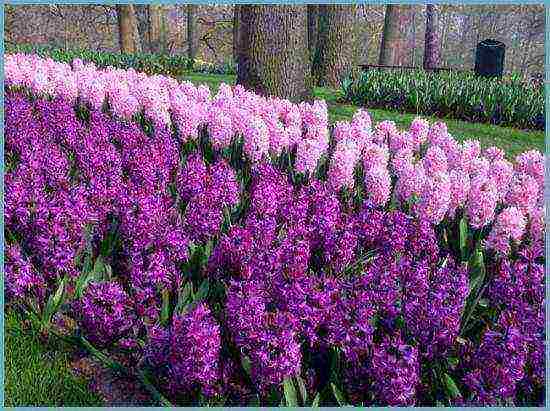
Eastern hyacinth
Blooming only once a season, hyacinths are usually distinguished by the timing of flowering: the garden culture can be early, medium and late flowering.
In the middle zone of our vast country, tender hyacinths bloom early, making up a worthy company for the first tulips. The weather conditions inherent in a particular region can shift the flowering time by 2-3 weeks, therefore these plants are considered very sensitive to climate and air temperature. The flowering process lasts from 7 to 15 days, again taking into account whether the weather favors or not.
Planting a plant
The recommended time for planting hyacinths is autumn. If you live in the middle lane, then tune in to planting work in the first days of October, when the soil temperature drops to 10 ° C.
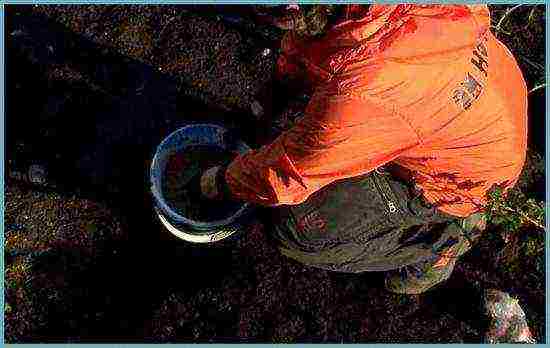
Plant hyacinths in the ground in the fall
Important! When choosing the moment for planting, first make sure that the bulbs of the plant can take root before the onset of frost. This will increase all the chances of wintering, and next spring your garden will be filled with colorful and fragrant hyacinths. Having planted flowers too early, you may not wait for the shoots: the bulbs will simply die. But too late planting threatens that the bulbs will not have time to form their root system, and the soil will already freeze.
When choosing a place for planting, remember that warm countries are the birthplace of capricious hyacinths, therefore, they should be planted on sunny and calm hills, having prepared the soil in advance. The flower makes special demands on it: the soil must be permeable to water with a considerable amount of humus. However, it is better not to resort to using fresh and slightly decomposed humus. If the soil is dense and clayey, then it is mixed with peat and sand. On soil with high acidity, the gardener will not be able to grow a luxurious flower bed, so such soil will have to be diluted with limestone or chalk.
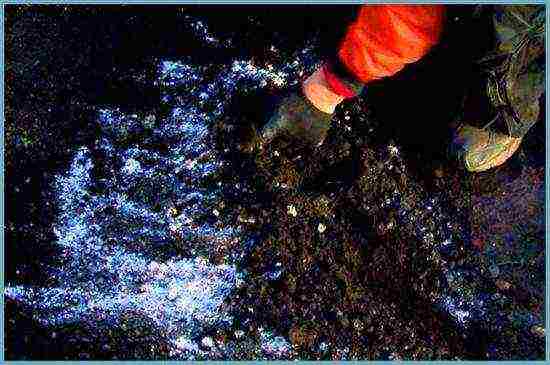
Soil liming
Attention! The soil for planting is dug up to a depth of 40 cm, mixed with mineral and organic dressings, if necessary, lime is added.Then the soil is leveled and covered with foil awaiting planting. This will help to avoid weeds.
Before planting, the material is carefully viewed. It is better to get rid of soft and diseased bulbs right away. Use medium-sized bulbs for planting, as the plants grown from them will be easier to withstand bad weather, but larger bulbs are more suitable for forcing.
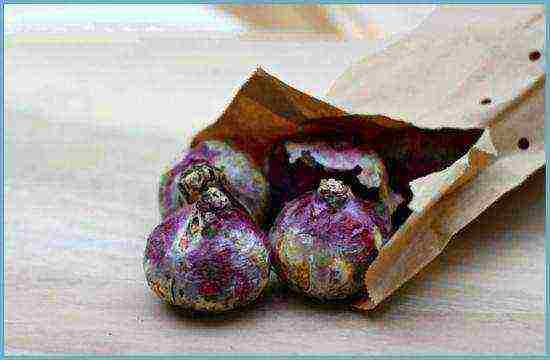
Hyacinth bulbs
Bulbs of hyacinths are planted to a depth of 15-17 cm at a distance of 15 cm from each other. If the baby is shallow, then the depth and distance will have to be slightly reduced. After completing planting work, the soil is covered with a mulching layer (sawdust, peat, fallen leaves), and after the temperature drops to 0 ° C and the appearance of persistent cold weather, it is covered with a film or other covering material, which is removed in early spring, when the soil thaws a little.
Hyacinth care
Delicate and quivering hyacinths used in landscape design are very demanding to care for, so special attention should be paid to the cleanliness of the soil around the seedlings. It loosens periodically. This will help create favorable growing conditions for the plant. If your hyacinths are not happy with abundant flowering, then the soil is probably not sufficiently moistened.
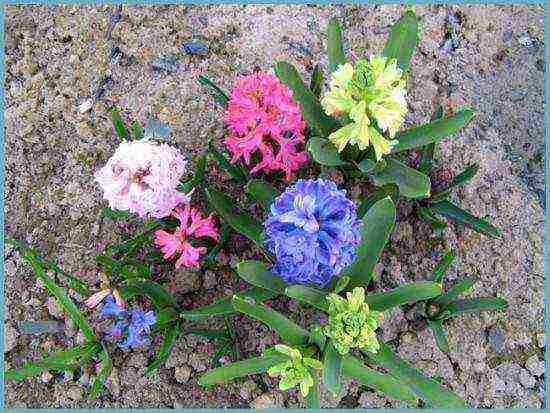
Be sure to loosen the soil around the hyacinths
Hyacinths are very fond of water, they especially need moisture in the dry season. During its growing season, the plant requires feeding, and culling, which is carried out 2-3 times per season, is considered a mandatory preventive measure. The peduncle does not break off with your hands, but is carefully cut with a knife, if it is not planned to cut hyacinths at all, then the wilted flowers break off, and the peduncle is left.
Fertilizing and feeding hyacinths
The key to growing flowering plants is regular feeding. The first time mineral feeding occurs in early spring, when sprouts are just beginning to appear. Superphosphate, ammonium nitrate or potassium chloride can be used as fertilizers. With the formation of the first buds, the plant is fed a second time using the same fertilizers. The culture is fed for the third time after flowering, when the hyacinth must store nutrients for the formation of renewal buds and the laying of axillary buds. For feeding, potash, phosphorus fertilizers are used, as well as potassium chloride and superphosphate, previously dissolved in water.
Advice! After applying the necessary fertilizers, the soil is loosened thoroughly!
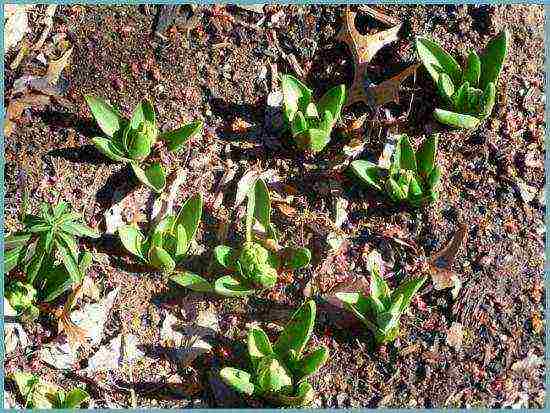
To make the plant feel comfortable, it is better to mulch the soil
Plant propagation
Usually, breeders use the seed method to breed varieties. Cultures grown in this way will delight with their colorful inflorescences only after 5-7 years. Seeds are sown closer to October in a container with soil mixed with humus and fine sand, and grown in closed greenhouses for 2 years.
The process of natural reproduction of flowers is extremely slow. An adult bulb can form as little as one to three babies. If the baby is easy to separate from the mother's bulb, then it is grown separately, otherwise it is not broken off, but planted in the ground along with the mother's bulb.
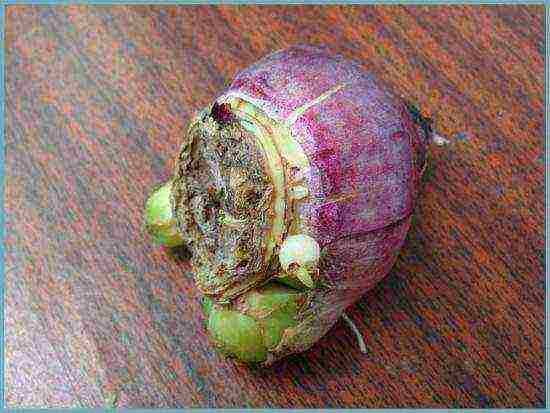
Sprouting hyacinth bulb
The bulbs selected for reproduction are pretreated with a solution of potassium permanganate (1%), and dried over the next two days.
Diseases and pests
Grown hyacinths rarely suffer from pests and are almost immune to disease. However, if signs of pest damage were noticed (cessation of growth, curvature of peduncles, wilting or yellowing), then the reasons may be as follows:
- contaminated material was used for planting;
- unsuitable soil (waterlogged or acidic);
- excess mineral feeding;
- incorrect culling of bulbs for planting;
- incorrectly carried out prevention;
- violation of the landing rules.
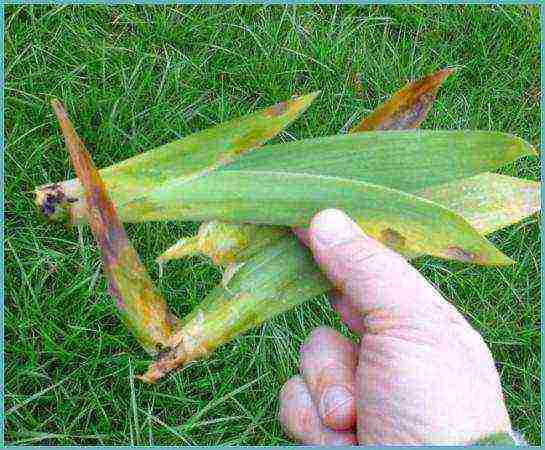
Hyacinth disease bacterial rot
Of the diseases that hyacinth can encounter, the most common is bacterial yellow rot, which turns the bulbs into a slimy formation with a pungent odor. As a result of infection, the culture stops growing, and spots and stripes may form on the leaves. The diseased plant must be removed from the flower bed, and the vacant hole is carefully etched with bleach.
Hyacinths: Combination with other plants
In landscape design, fabulous hyacinths are perfectly combined with many spring bulbous plants that bloom at about the same period as the hyacinth. The most organic and picturesque tandem is formed by:
- bright blue hyacinths and sun daffodils;
- blue hyacinths and white tulips;
- orange blossom hyacinths and scarlet tulips.
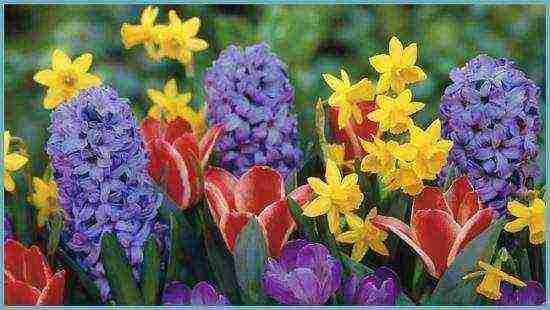
Hyacinths look great with other spring flowers
Hyacinths in landscape design
Hyacinth is a versatile flower, because it is successfully grown in flower beds outdoors, in flowerpots and pots on windowsills. These flowering plants of one color scheme look unusually elegant in the company of lush and undersized perennial crops. A garden path framed by well-groomed hyacinths, as well as trees and bushes decorated with them, will look wonderful. Gardeners assure that it is better to plant hyacinths together with other plants, so that after they have faded, the soil is not empty.
Growing hyacinth at home: video
Hyacinths in the garden: photo
